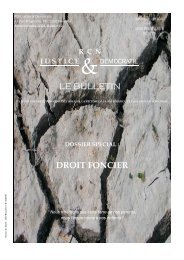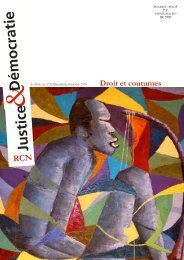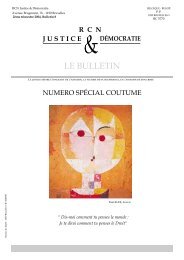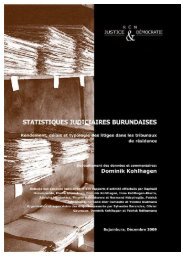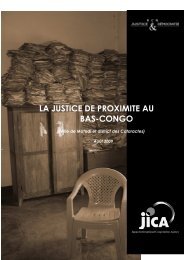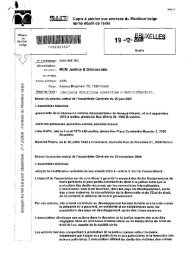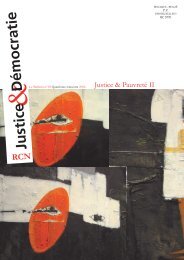Démocratie Démocratie
Extrait du Bulletin 32 - RCN Justice & Démocratie
Extrait du Bulletin 32 - RCN Justice & Démocratie
You also want an ePaper? Increase the reach of your titles
YUMPU automatically turns print PDFs into web optimized ePapers that Google loves.
cases are judged in absentia, the public attends no<br />
more than 21% of the trials and the conviction rate<br />
stands at 55% (most of which, of course, involve<br />
absent defendants).<br />
For these reasons our team members engaged in a<br />
constructive dialogue with high ranking officials at<br />
the NPPA to find a structural and effective solution to<br />
the backlog problem. In our assessment, what is<br />
needed is a structural solution to a structural problem.<br />
This solution should have a number of characteristics.<br />
(1) It must be aimed at preventing the<br />
build-up of backlogs rather than at working them<br />
away once they have accumulated. In other words, it<br />
should rationalize and accelerate the process of dealing<br />
with newly incoming and backlogged cases, so<br />
that existing backlogs can be liquidated and the total<br />
case load can be progressively reduced. (2) This<br />
means that cases with a low probability of resulting<br />
in a conviction should be filtered out and dismissed<br />
at an early point in the process. (3) Crucially, the<br />
system should not rely on an increase of capacity to<br />
produce results, since it is not realistic to expect<br />
that, in the medium term, the NPPA will be able to<br />
significantly and permanently expand its workforce.<br />
decisions. It appears advisable for the proper functioning<br />
of this system that the NPPA organizes its<br />
prosecutors in teams. The prosecutors working on<br />
case marking should not work on the completion of<br />
files and trials at the same time.<br />
We have recently issued a report – written by a<br />
senior Scottish prosecutor who knows the Rwandese<br />
justice system very well – that presents detailed proposals<br />
for the case marking system and the reorganization<br />
in teams and identifies the steps to be followed<br />
and the obstacles that may be encountered.<br />
RCN has agreed with the NPPA that we will jointly<br />
seek funding to further develop, implement and test<br />
(in the IPOs of Gicumbi and Muhanga) this timebound<br />
process for handling cases in a four month<br />
pilot project.<br />
Marco LANKHORST,<br />
Coordonateur des programmes.<br />
The way to achieve the results identified under (1)<br />
is to introduce a rigorous and time-bound case selection<br />
procedure. Case selection must be based on a<br />
set of clearly defined case selection criteria.<br />
The following are examples of selection criteria:<br />
- The seriousness of the allegation (the type of<br />
crime, the impact on the public, the impact on the<br />
victim and the economic value of the goods at<br />
stake);<br />
- The credibility of the allegation in light of the<br />
already available evidence (in other words, how<br />
probable is it that further investigation and trial will<br />
eventually result in a conviction );<br />
- The time that has passed since the date of the<br />
alleged crime;<br />
- Prosecution priorities (these can be general,<br />
e.g. Rwanda wants to have a zero-tolerance policy<br />
on corruption, or specific, in the sense that they relate<br />
to how frequently a certain type of crime has<br />
occurred over a certain area within a certain period);<br />
- The question whether the accused is a repeat<br />
offender.<br />
Depending on the answers to these questions, incoming<br />
cases are marked by means of a uniform<br />
marking (or scoring) system. The markings will divide<br />
cases into three categories: (1) cases to be dismissed<br />
immediately, (2) cases that require further<br />
investigation and (3) cases that can be transferred to<br />
court immediately. The aim should be to set a strict<br />
quantitative limit on the amount of cases that can be<br />
brought within the intermediate category. Strict and<br />
short deadlines should be established for ranking<br />
incoming cases, as well as for taking the associated<br />
© Franck Dikisongele<br />
13




